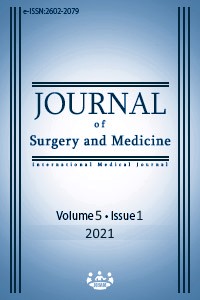Myocardial infarction with non-obstructive coronary artery disease, a retrospective cohort study: Are plaque disruption and other pathophysiological mechanisms the same disease?
Keywords:
microvascular dysfunction, MINOCA, plaque disruption, SCAD, vasospasmAbstract
Backgound/Aim: Myocardial infarction with non-obstructive coronary arteries (MINOCA) is an increasingly recognized entity. Recent studies have shown that MINOCA is not a benign syndrome, with younger MINOCA patients having outcomes comparable to their myocardial infarction with obstructive coronary artery disease (MI-CAD) counterparts. In this study, we will describe the demographic, clinical and angiographic characteristics of MINOCA patients in our hospital. Methods: In this retrospective cohort study, all patients who underwent coronary angiography with the diagnosis of acute coronary syndrome during September 2016-April 2019 were screened and those with MINOCA were detected. We described the demographic, clinical, and angiographic characteristics of MINOCA patients and compared the etiologic and pathophysiological mechanisms. Results: A total of 3855 patients with acute coronary syndrome were screened and 155 were diagnosed with MINOCA, with a total prevalence of 4.02%. Among them, 48.4% were female and the overall mean age was 55.04 (13.57) years. Plaque disruption was the most common cause of MINOCA (48.4%), which was followed by microvascular dysfunction and slow flow (9.7%). We compared plaque disruption and other causes to find that age (58.31 (13.76) vs 51.89 (12.68) P=0.003), hypertension (37 (48.7%) vs 25 (31.6%) P=0.034), prior coronary artery disease history (16 (21.1%) vs 2 (2.5%) P=0.001) and creatinine clearance (67.35 (IQR: 25.8) vs 74.0 (IQR: 28.58) P=0.009) were higher in patients with plaque disruption than those without. Conclusion: MINOCA is a diagnosis of exclusion with numerous potential causes. The etiological and pathophysiological mechanisms of plaque disruption are different from other causes of MINOCA and the correct treatment approach determines the prognosis.
Downloads
References
Agewall S, Beltrame JF, Reynolds HR, Niessner A, Rosano G, Caforio AL, et al. ESC working group position paper on myocardial infarction with non-obstructive coronary arteries. European heart journal. 2016;38(3):143-53.
Pasupathy S, Air T, Dreyer RP, Tavella R, Beltrame JF. Systematic review of patients presenting with suspected myocardial infarction and nonobstructive coronary arteries. Circulation. 2015;131(10):861-70.
Tamis-Holland JE, Jneid H, Reynolds HR, Agewall S, Brilakis ES, Brown TM, et al. Contemporary diagnosis and management of patients with myocardial infarction in the absence of obstructive coronary artery disease: a scientific statement from the American heart association. Circulation. 2019:CIR. 0000000000000670.
Alpert JS. Myocardial infarction with angiographically normal coronary arteries. Archives of internal medicine. 1994;154(3):265-9.
DeWood MA, Stifter WF, Simpson CS, Spores J, Eugster GS, Judge TP, et al. Coronary arteriographic findings soon after non-Q-wave myocardial infarction. New England Journal of Medicine. 1986;315(7):417-23.
Beltrame JF. Assessing patients with myocardial infarction and nonobstructed coronary arteries (MINOCA). Journal of internal medicine. 2013;273(2):182-5.
Safdar B, Spatz ES, Dreyer RP, Beltrame JF, Lichtman JH, Spertus JA, et al. Presentation, clinical profile, and prognosis of young patients with myocardial infarction with nonobstructive coronary arteries (MINOCA): results from the VIRGO study. Journal of the American Heart Association. 2018;7(13):e009174.
Lindahl B, Baron T, Erlinge D, Hadziosmanovic N, Nordenskjöld A, Gard A, et al. Medical therapy for secondary prevention and long-term outcome in patients with myocardial infarction with nonobstructive coronary artery disease. Circulation. 2017;135(16):1481-9.
Thygesen K, Alpert JS, Jaffe AS, Chaitman BR, Bax JJ, Morrow DA, et al. Fourth universal definition of myocardial infarction (2018). Journal of the American College of Cardiology. 2018;72(18):2231-64.
Levin DC, Fallon JT. Significance of the angiographic morphology of localized coronary stenoses: histopathologic correlations. Circulation. 1982;66(2):316-20.
Chan KH, Ng MK. Is there a role for coronary angiography in the early detection of the vulnerable plaque? International journal of cardiology. 2013;164(3):262-6.
Saw J. Coronary angiogram classification of spontaneous coronary artery dissection. Catheterization and Cardiovascular Interventions. 2014;84(7):1115-22.
Adlam D, Alfonso F, Maas A, Vrints C, Committee W. European Society of Cardiology, acute cardiovascular care association, SCAD study group: a position paper on spontaneous coronary artery dissection. European Heart journal. 2018;39(36):3353.
Wiviott SD, Braunwald E, McCabe CH, Montalescot G, Ruzyllo W, Gottlieb S, et al. Prasugrel versus clopidogrel in patients with acute coronary syndromes. New England Journal of Medicine. 2007;357(20):2001-15.
Wallentin L, Becker RC, Budaj A, Cannon CP, Emanuelsson H, Held C, et al. Ticagrelor versus clopidogrel in patients with acute coronary syndromes. New England Journal of Medicine. 2009;361(11):1045-57.
Jędrychowska M, Januszek R, Plens K, Surdacki A, Bartuś S, Dudek D. Impact of sex on the follow-up course and predictors of clinical outcomes in patients hospitalised due to myocardial infarction with non-obstructive coronary arteries: a single-centre experience. Kardiologia Polska (Polish Heart Journal). 2019;77(2):198-206.
Opolski MP, Spiewak M, Marczak M, Debski A, Knaapen P, Schumacher SP, et al. Mechanisms of myocardial infarction in patients with nonobstructive coronary artery disease: results from the Optical Coherence Tomography study. JACC: Cardiovascular Imaging. 2018.
Reynolds HR, Srichai MB, Iqbal SN, Slater JN, Mancini GJ, Feit F, et al. Mechanisms of myocardial infarction in women without angiographically obstructive coronary artery disease. Circulation. 2011;124(13):1414-25.
Sinclair H, Bourantas C, Bagnall A, Mintz GS, Kunadian V. OCT for the identification of vulnerable plaque in acute coronary syndrome. JACC: Cardiovascular Imaging. 2015;8(2):198-209.
Montone RA, Niccoli G, Fracassi F, Russo M, Gurgoglione F, Cammà G, et al. Patients with acute myocardial infarction and non-obstructive coronary arteries: safety and prognostic relevance of invasive coronary provocative tests. European heart journal. 2017;39(2):91-8.
Gościniak P, Baron T, Jozwa R, Pyda M. The tip of the iceberg: cardiac magnetic resonance imaging findings in patients with myocardial infarction with non-obstructive coronary arteries: preliminary data from the Polish single-centre registry. Kardiologia polska. 2019;77(3):389-92.
Downloads
- 632 639
Published
Issue
Section
How to Cite
License
Copyright (c) 2021 Serkan Asıl, Veysel Özgür Barış, Muhammet Geneş, Hatice Taşkan, Suat Görmel, Erkan Yıldırım, Yalçın Gökoğlan, Murat Çelık, Uygar Çağdaş Yüksel, Hasan Kutsi Kabul, Cem Barçın
This work is licensed under a Creative Commons Attribution-NonCommercial-NoDerivatives 4.0 International License.
















